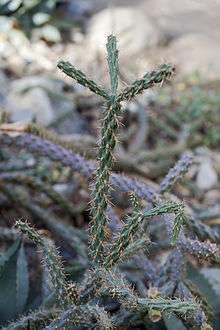Ambrosia deltoidea
Ambrosia deltoidea is a North American species of flowering plant in the aster family known by the common names triangle bur ragweed, triangle bursage, and triangleleaf bursage.[3]
| Ambrosia deltoidea | |
|---|---|
 | |
| Scientific classification | |
| Kingdom: | Plantae |
| Clade: | Tracheophytes |
| Clade: | Angiosperms |
| Clade: | Eudicots |
| Clade: | Asterids |
| Order: | Asterales |
| Family: | Asteraceae |
| Genus: | Ambrosia |
| Species: | A. deltoidea |
| Binomial name | |
| Ambrosia deltoidea (Torr.) Payne | |
| Synonyms[1][2] | |
| |
Distribution
The plant is native to the Sonoran Desert region of North America, where it can be found in Baja California, Baja California Sur, and Sonora in Mexico, with its distribution extending north into Arizona in the United States.[4][5][6]
This shrub grows in desert habitat, such as desert grasslands and shrublands. It is a dominant or codominant species, and one of the most abundant plants,[7] in the Arizona Upland Subdivision of the Sonoran Desert.[4] It may occur in upper and lower bajadas, but it is most often found in the ecotone between them. It can be found in open areas. It grows on steep, rocky slopes alongside cacti such as the saguaro and paloverde such as the yellow paloverde. Other plants in the habitat include condalia, ocotillo, jatropha, and prickly pears. The bursage easily invades grassland that has been overgrazed. Areas protected from grazing have less bursage.[4][8][9][10]
Description
Ambrosia deltoidea is a shrub growing from a taproot with many lateral and adventitious roots. The plant produces many thin branches growing up to about half a meter tall. It generally has many dead branches tangled in the living crown. It is drought-deciduous. The leaves are no more than 2 centimeters long. The branches and new leaves are coated thinly in woolly fibers; the leaves become hairless with age.
The inflorescence is a spike of several staminate flower heads. There are often some pistillate heads just below these, with some pistillate heads borne on lateral branches. The fruit is an achene covered in spines. The achenes are usually dispersed when they stick to animals. The plant has been observed to have a lifespan of about 50 years.[4]
Uses
This plant acts as a nurse plant for other species, providing shade and increased soil nitrogen for young growing plants. It also protects seedlings from herbivory. It is the main nurse plant for saguaro in Organ Pipe National Monument.[4] It also serves as nurse plant for yellow paloverde, ocotillo, and some prickly pear species.[7] Most bursage plants are associated with a perennial plant.[4]
This plant is not palatable to mammals and it is not grazed by livestock.[4]
Airborne allergens from this plant can cause contact dermatitis in humans.[11]
References
- The Plant List, Ambrosia deltoidea (Torr.) W.W.Payne
- Tropicos, Franseria deltoidea Torr.
- United States Department of Agriculture Plants Profile for Ambrosia deltoidea
- Marshall, K. Anna. 1994. Ambrosia deltoidea. In: Fire Effects Information System, [Online]. U.S. Department of Agriculture, Forest Service, Rocky Mountain Research Station, Fire Sciences Laboratory.
- Tropicos, specimen listing for Ambrosia deltoidea (Torr.) W.W. Payne
- Biota of North America Program 2014 county distribution map
- Bowers, J. E. (2002). Regeneration of triangle-leaf bursage (Ambrosia deltoidea: Asteraceae): Germination behavior and persistent seed bank. The Southwestern Naturalist 47(3) 449-53.
- Torrey, John 1853. Smithsonian Contributions to Knowledge 6(2): 15–16 description in English as Franseria deltoidea
- Payne, Willard William 1964. Journal of the Arnold Arboretum 45(4): pages 421-422 description in English
- Payne, Willard William 1964. Journal of the Arnold Arboretum 45(4): plate IV (4), figures 30-34 line drawings of Ambrosia deltoidea; figure captions on page 429
- Schumacher, M. J. and N. G. Silvis. (2003). Airborne contact dermatitis from Ambrosia deltoidea (triangle-leaf bursage). Contact Dermatitis 48(4) 212-16.
External links
- Arizona-Sonora Desert Museum
- Ambrosia deltoidea — Calphotos Photo Gallery, University of California
- Master Gardeners of the University of Arizona Pima County Cooperative Extension
- Virginia Tech vTree Fact Sheet, triangleleaf bursage Asteraceae Ambrosia deltoidea (Torr.) Payne
- Pollen Library, IMS Health, Triangle Burr-Ragweed (Ambrosia deltoidea)
